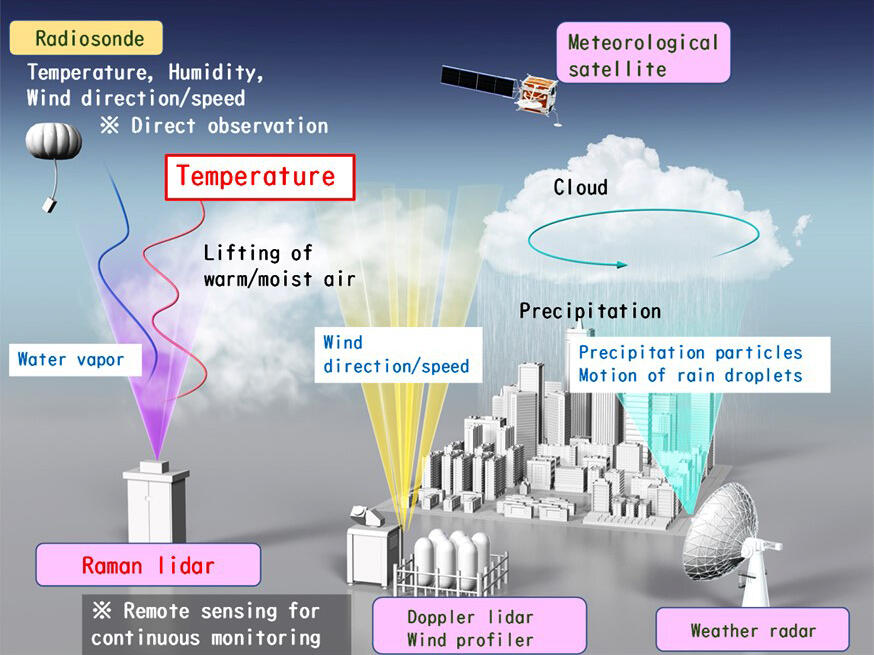Water-related disasters are increasing due to extreme weather events. If we can observe the vertical profiles of air temperature and water vapor in the atmospheric boundary layer, from the earth's surface to 1 to 2 km altitude, with high frequency and accuracy, we can make a significant contribution to understanding the local precipitation processes that cause such disasters and improve the accuracy of weather forecasts.
A research group led by Specially Appointed Associate Professor Masanori Yabuki at the Research Institute for Sustainable Humanosphere, Kyoto University, and EKO Instruments Co., Ltd. have jointly developed a multi-wavelength spectroscopic detector with low stray light for Raman lidars that use laser light at deep ultraviolet wavelengths to measure vertical temperature distributions. By adding it to a Raman lidar that has already been developed to measure the vertical distribution of water vapor, it will enable the stable simultaneous measurement of temperature and water vapor at both day and night. It is expected to contribute to greater accuracy in forecasting training and localized heavy rainfalls. "We have reached the point where we can estimate the temperature based on observations using optical systems with minimal stray light that we have constructed over the past 10 years," explains Specially Appointed Associate Professor Yabuki. "Moving forward, we would like to promote efforts toward bringing this to society in order to respond to increasingly severe weather and water disasters."

Provided by Kyoto University
Since 2014, Kyoto University and EKO Instruments have been jointly developing a Raman lidar to measure the distribution of air temperature and water vapor from the ground. Raman lidar is expected to be able to forecast the onset of clouds that bring heavy rainfall earlier because it can capture the vertical distribution of water vapor content, which is difficult to detect using radar and other methods.
The water vapor Raman lidar, which was completed earlier, has been used for demonstration observations in forested and urban areas and is now being commercialized. The air temperature Raman lidar uses the property that the spectral shape of the rotational Raman scattering light from air molecules varies with temperature to estimate air temperature. Conventional methods capture some changes in the spectral shape by measuring the intensity of scattered light at only two wavelengths using interference filters, but this requires filters with high wavelength precision and lasers with frequency stabilization controllers, as well as sophisticated adjustment of optical systems such as optical incidence angles.
The multi-wavelength spectroscopic detector developed in this research can capture the shape of the rotational Raman scattering light spectrum that appears on both sides of the laser wavelength with high wavelength resolution by using a monochromator and an array detector and can estimate temperature with high accuracy. The measurement wavelength can also be adjusted by changing the angle of the diffraction grating through software controls, eliminating the need for advanced optical system adjustment techniques. However, stray light caused by strong elastic scattered light that appears at the center of the wavelength of the rotational Raman scattering light spectrum hinders accurate spectral measurement and reduces the accuracy of temperature estimates.
Therefore, the research group developed a multi-wavelength spectroscopic detector that attenuates the stray light effect due to elastic scattered light to the power of 10-7 or less. The developed multi-wavelength spectroscopic detector connects two monochromators using diffraction gratings, and a spatial filter that attenuates only specific wavelengths in the optical path of the two monochromators allows elastic scattered light to be attenuated while minimizing spectral distortion. High wavelength resolution detection is possible as the spectral intensity is measured wavelength by wavelength with an array detector, making it applicable to Raman lidars using lasers at deep UV wavelengths, where the width of the rotational Raman scattered light spectrum is narrower.
Also, Raman lidars, which detect faint scattered light from the atmosphere, have problems with their observation accuracy during the daytime when sunlight overlaps as noise. The group has subsequently developed a water vapor Raman lidar using a laser at deep ultraviolet wavelengths (solar blind wavelengths), which are almost entirely absent in sunlight, and have succeeded in making continuous stable observations of water vapor levels throughout the year, day and night.
The deep-ultraviolet water vapor Raman lidar was combined with the newly developed temperature measurement unit, and a demonstration experiment was conducted at the Shigaraki MU Observatory of the Research Institute for Sustainable Humanosphere, Kyoto University. The strong elastic scattering light near the center of the spectrum was eliminated. A comparison of air temperatures measured by the Raman lidar with those observed by radiosondes, which are released from balloons with direct observation equipment suspended from them, showed a consistent air temperature distribution down to an altitude of about 1,000 meters near the atmospheric boundary layer.
Moving forward, the research group will work on improving stability and maintainability and promote the practical application of Raman lidar for simultaneous measurement of air temperature and water vapor for social implementation.
This article has been translated by JST with permission from The Science News Ltd.(https://sci-news.co.jp/). Unauthorized reproduction of the article and photographs is prohibited.




